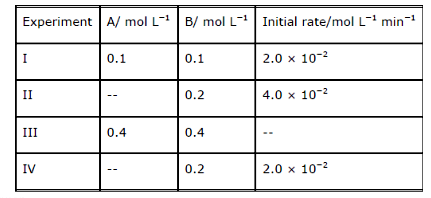If reaction between A and B to give C shows first order kinetics in A and second order in B, the rate equation can be written as
Rate =k[A][B]1/2
Rate =k[A]1/2[B]
Rate =k[A][B]2
Rate =k[A]2[B]
The correct Answer is:C
Rate = k[A][B]2.
Topper's Solved these Questions
- BOOK - DINESH PUBLICATIONCHAPTER - RATES OF REACTIONS AND CHEMICAL KINETICSEXERCISE - Selected Straight49videos
RATES OF REACTIONS AND CHEMICAL KINETICS
- BOOK - DINESH PUBLICATIONCHAPTER - RATES OF REACTIONS AND CHEMICAL KINETICSEXERCISE - Comprehension13videos
RATES OF REACTIONS AND CHEMICAL KINETICS
- BOOK - DINESH PUBLICATIONCHAPTER - RATES OF REACTIONS AND CHEMICAL KINETICSEXERCISE - Ultimate Preparatory Package29videos
RATES OF REACTIONS AND CHEMICAL KINETICS
- BOOK - DINESH PUBLICATIONCHAPTER - PHYSICAL AND CHEMICAL EQUILIBRIAEXERCISE - ULTIMATE PREPARATORY PACKAGE13videos
PHYSICAL AND CHEMICAL EQUILIBRIA
- BOOK - DINESH PUBLICATIONCHAPTER - REDOX REACTIONSEXERCISE - Reasoning Type Questions4videos
REDOX REACTIONS
Similar Questions
Knowledge Check
- Question 1 - Select One
Rate equation for a second order is
AK=2.303tlogaa−xBK=1tlogaa−xCK=1tlogaa(a−x)DK=1t2logaa−x
A reaction is of first order in reactant A and of second order in reactant B. How is the rate of this reaction affected when (i) the concentration of B alone is increased to three times. (ii) the concentrations of A as well as B are doubled?
View SolutionA reaction is of first order in reactant A and of second order in reactant B. How is the rate of this reaction affected when (i) the concentration of B alone is increased to three times (ii) the concentrations of A as well as B are doubled?
View SolutionA reaction is of first order in reactant A and of second order in reactant B. How is the rate of this reaction affected when (i) the concentration of B alone is increased to three times (ii) the concentrations of A as well as B are doubled?
View SolutionThe reaction between A and B is first order with respect to A and zero order with respect to B. Fill in the blanks in the following table :
 View Solution
View SolutionThe reaction between A and B is first order with respect to A and zero order with respect to B. Fill in the blanks in the following table.
 View Solution
View SolutionThe reaction between A and B is first order with respect to A and zero order with respect to B. Fill in the blanks in the following table:
 View Solution
View SolutionA reaction is first order in A and second order in B
(i) Write the differential rate equation.
(ii) How is the rate affected on increasing the concentation of B three times ?
(iii) How is the rate affected when the concentration of both A and B are doubled ?View Solution

